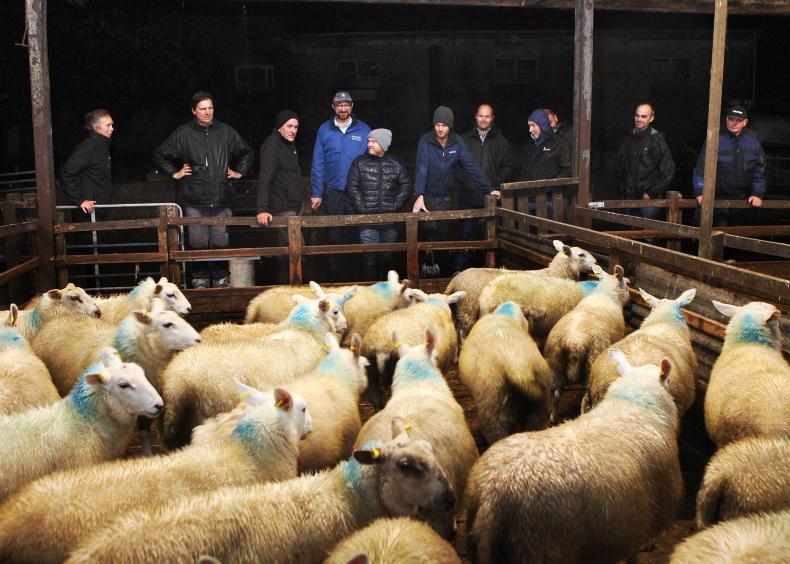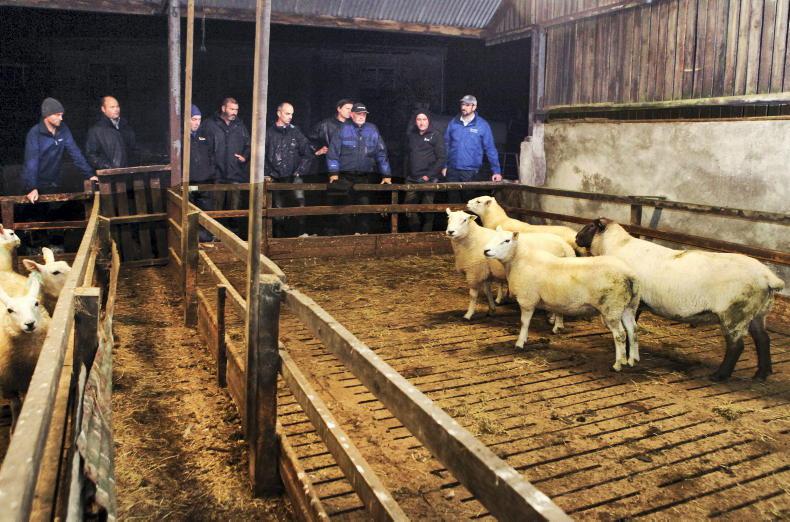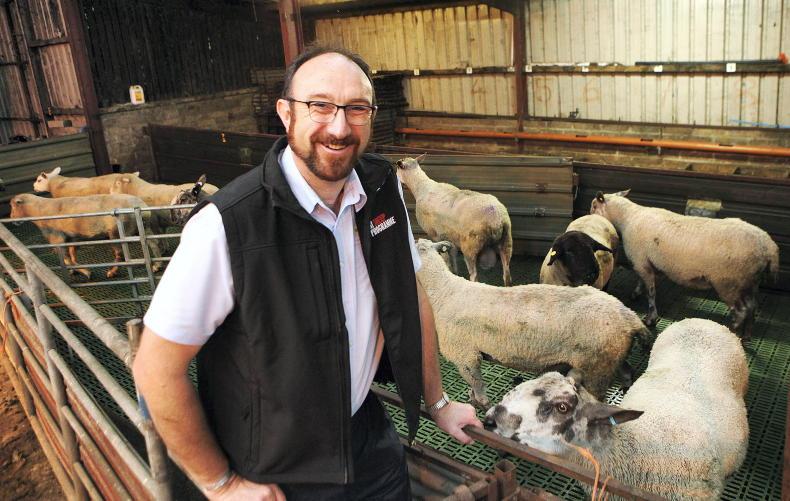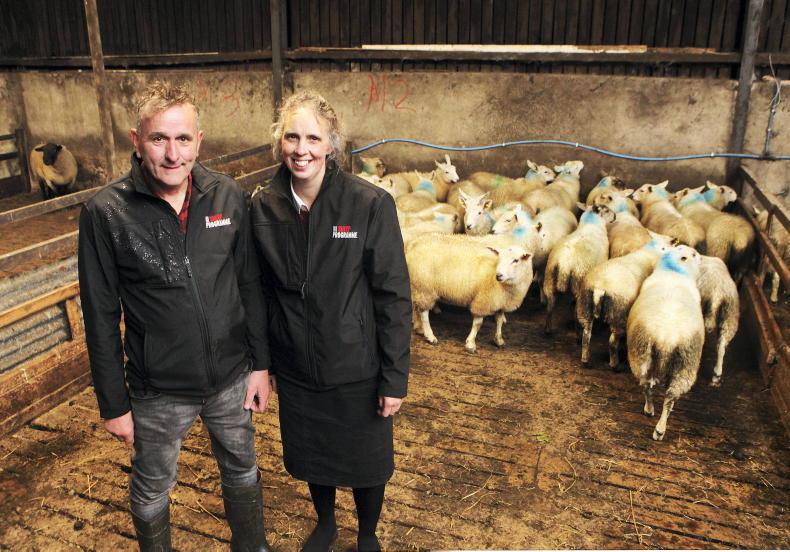Following on from their visit to Co Antrim a few weeks ago, participants in the Northern Ireland Sheep Programme (NISP) travelled west to Tempo, Co Fermanagh, for a discussion group meeting on the lowland farm of Roy and Marilyn Mayers.
The all-grass farm is in a Severely Disadvantaged Area (SDA) experiencing high rainfall levels. Hence, the land generally becomes wet earlier than in other parts of Northern Ireland.
As such, the Mayers have become strongly focused on growing and utilising grass when the weather and ground conditions allow.
One block
The farm consists of 120 acres (48.5ha) of grassland, all in one block. In addition, there are 60 acres of lakes, lanes, yards and woodland.

Members of the Northern Sheep Programme having a closer look at replacement ewe lambs during the NI Sheep Programme walk on Roy Mayers' farm in Co. Fermanagh last week. \ Houston Green
The farm block has increased by about 20ha since joining the programme in 2019 as Roy’s father has stepped back from farming and Roy and Marilyn have taken on the majority of this land.
The focus of the evening centred on the farm’s use of genetic information and production data when purchasing rams and selecting sward mixtures.
This ties in with the emphasis on maximising output efficiently through the use of superior genetics and aspects such as growing clover to reduce the need for chemical fertiliser and addressing soil pH.
The bedrock of a successful grass growing system is soil fertility and this is an area that the Mayers have really focused on. The farm always applies ground lime when required and through regular soil testing, zero-phosphorus fertilisers are now only spread. With the inclusion of clover, the amount of nitrogen applied has decreased, reducing the annual fertiliser bill significantly.
While the Mayers had undertaken some paddocking of grazing ground in recent years, joining the Northern Ireland Sheep Programme has encouraged them to push forward with this infrastructure and they are strong advocates for paddocking.
In encouraging other sheep farmers to give paddocks a go, they highlight that they have found the use of electric fencing to be a relatively cheap way of enhancing grazing infrastructure. They have found it easy to set up and a system that sheep get used to remarkably quickly.
Using the paddock grazing system and grass measuring combined they have found that they are growing and utilising more grass.
Sheep enter swards at the most appropriate height to sustain high levels of animal performance and paddocks are grazed and vacated quickly, speeding up recovery times. This, and the continued inclusion of clover in their reseeds, is beginning to make a real difference on the farm.
With the paddock system and the inclusion of clover, the group viewed some very commendable clover swards.
Roy, who had a commercial background in the grass seed industry and strong interest in grass mixtures, stated on the evening that he would add at least 1.5kg/acre of AberDai clover seed (medium leaf clover) into his reseed mixtures.
He also advocates using relatively simple grass seed mixes, with only three or four varieties. In choosing grass varieties, Roy uses the pasture profit index, which he has found very beneficial.
In addition, he finds the inclusion of Festulolium varieties (natural hybrid between fescue and ryegrass) to be an advantage on the farm due to its deep root structure.
Roy also found that restricting the level of inclusion of diploid grass varieties in his mixtures encouraged the development of the clover. Diploid varieties are generally denser growing and could suppress the growth of the clover. Roy noted that docks have been a problem. However, spot spraying, while time-consuming, has been beneficial in their control.
In addition, the Mayers have also planted some chicory and plantain with some of their reseeds.
Sheep have performed satisfactorily on these herbs, with the issue being persistency and cost relative to the length of time the crop is available for grazing.
With the successful inclusion of clover in a lot of the swards, in conjunction with the paddock system, the Mayers are experiencing the luxury of having excess grass during the grazing season, which has been baled this year. This has boosted feed reserves, with approximately 500 bales conserved in 2021.
To some, this sounds like a high volume of winter forage but due to the long winters experienced in this part of the country, no winter grazing of the ewes being undertaken, and the addition of contract feeding dairy heifers on the farm this winter, all these bales will be required.
While there is a silo on the farm, the Mayers have found that its relatively wide pit face resulted in silage undergoing secondary fermentation in the past, which is why they returned to baled silage.
In addition, their silage contractor lives relatively close so bales can be done in a timely manner, which fits in to the focus of managing grass and taking surplus grass out of the rotation.
The farm runs approximately 225 Texel, Suffolk and Belclare cross ewes and 100 ewe lambs.
The inclusion of Belclare genetics over the last few years has both increased the lambing percentage and, ultimately, ewe numbers to a sustainable number for the farm. Their next challenge is to maintain this level of fertility.

The New Zealand Suffolk ram is a powerful sheep. \ Houston Green
The scanning rate in mature ewes has increased above two lambs per ewe joined, while the weaning rate is excellent at 1.89 lambs.
While the Mayers are pretty satisfied with the maternal side of the flock, they felt that they needed to improve the terminal side. They have also focused in recent years on sourcing rams which suit a grass-based system and are easier to finish off grass with the aim of reducing the volume of concentrates required to finish lambs.
There is an extensive ram team used including New Zealand Suffolk, Texel, Belclare, Chartex, Durno and Suftex rams.
The Chartex is a Charollais x Texel ram. The Durno also incorporates Chaollais and Texel genetics with the name trademarked by the Scottish Logie Durno flock on which they are bred while a Suftex is a Suffolk and Texel hybrid.
The move away from their conventional breeding system started two years ago when Roy sourced their New Zealand Suffolk as a ram lamb from a pedigree breeder in England trading under EasyRams.
The now two-year-old has proven successful and was put with 80 ewes in 2020 and with the same number this year with confidence. Roy stated that this ram is out all year on the farm and receives no meal.
Impressed with this ram’s performance, the Mayers have returned to the same breeder and purchased a New Zealand Suftex ram lamb which will be used this year for the first time along with the Durno ram.
Both of these sheep were primarily purchased on estimated breeding values (EBVs) and then through viewing videos of the rams from the breeders. Both these sheep have positive EBV figures for fat cover which the Mayers hope will fit in with their grass-based system.
Following an on-farm presentation to the group while on a visit to Wales in 2019, the Mayers decided to purchase a farm-recording management package. While Roy admitted that there is still much to learn about the system, it has enabled them to better focus on lamb performance, especially daily liveweight gain.
This enabled them to quickly identify underperforming sheep this summer, which resulted in both blood and grass samples being taken to determine if any mineral deficiencies are the cause of the problem.
The results of these are being eagerly awaited.
The farm has focused on operating a closed flock policy but such has been the rate of flock numbers increasing since 2019 that some ewe lambs have also been purchased from known sources.
Purchasing of these sheep with maternal traits also allowed the focus of the breeding programme to switch from terminally bred ewes to maternally bred ewes quicker and this is already paying dividends.
Marilyn said that this will hopefully be the last year where they will buy in replacements as the Belclare and New Zealand Suffolk influence should enable them to have enough homebred replacements to choose from.
There is a strong environmental focus on the farm, with numerous metres of hedgerow and tress planted. This is down to the Mayers’ involvement in various agri-environment schemes.
The farm has also recently been appointed as a technology demonstration farm for the farm habitat creation and management theme.
Roy said that the dual focus areas of maximising sheep production and creating wildlife habitats have worked really well.
Not only does the environmental work undertaken improve biodiversity and improve water quality but it also creates valuable shelter for livestock.

Senan White is NISP programme adviser. \ Houston Green
Following on from their visit to Co Antrim a few weeks ago, participants in the Northern Ireland Sheep Programme (NISP) travelled west to Tempo, Co Fermanagh, for a discussion group meeting on the lowland farm of Roy and Marilyn Mayers.
The all-grass farm is in a Severely Disadvantaged Area (SDA) experiencing high rainfall levels. Hence, the land generally becomes wet earlier than in other parts of Northern Ireland.
As such, the Mayers have become strongly focused on growing and utilising grass when the weather and ground conditions allow.
One block
The farm consists of 120 acres (48.5ha) of grassland, all in one block. In addition, there are 60 acres of lakes, lanes, yards and woodland.

Members of the Northern Sheep Programme having a closer look at replacement ewe lambs during the NI Sheep Programme walk on Roy Mayers' farm in Co. Fermanagh last week. \ Houston Green
The farm block has increased by about 20ha since joining the programme in 2019 as Roy’s father has stepped back from farming and Roy and Marilyn have taken on the majority of this land.
The focus of the evening centred on the farm’s use of genetic information and production data when purchasing rams and selecting sward mixtures.
This ties in with the emphasis on maximising output efficiently through the use of superior genetics and aspects such as growing clover to reduce the need for chemical fertiliser and addressing soil pH.
The bedrock of a successful grass growing system is soil fertility and this is an area that the Mayers have really focused on. The farm always applies ground lime when required and through regular soil testing, zero-phosphorus fertilisers are now only spread. With the inclusion of clover, the amount of nitrogen applied has decreased, reducing the annual fertiliser bill significantly.
While the Mayers had undertaken some paddocking of grazing ground in recent years, joining the Northern Ireland Sheep Programme has encouraged them to push forward with this infrastructure and they are strong advocates for paddocking.
In encouraging other sheep farmers to give paddocks a go, they highlight that they have found the use of electric fencing to be a relatively cheap way of enhancing grazing infrastructure. They have found it easy to set up and a system that sheep get used to remarkably quickly.
Using the paddock grazing system and grass measuring combined they have found that they are growing and utilising more grass.
Sheep enter swards at the most appropriate height to sustain high levels of animal performance and paddocks are grazed and vacated quickly, speeding up recovery times. This, and the continued inclusion of clover in their reseeds, is beginning to make a real difference on the farm.
With the paddock system and the inclusion of clover, the group viewed some very commendable clover swards.
Roy, who had a commercial background in the grass seed industry and strong interest in grass mixtures, stated on the evening that he would add at least 1.5kg/acre of AberDai clover seed (medium leaf clover) into his reseed mixtures.
He also advocates using relatively simple grass seed mixes, with only three or four varieties. In choosing grass varieties, Roy uses the pasture profit index, which he has found very beneficial.
In addition, he finds the inclusion of Festulolium varieties (natural hybrid between fescue and ryegrass) to be an advantage on the farm due to its deep root structure.
Roy also found that restricting the level of inclusion of diploid grass varieties in his mixtures encouraged the development of the clover. Diploid varieties are generally denser growing and could suppress the growth of the clover. Roy noted that docks have been a problem. However, spot spraying, while time-consuming, has been beneficial in their control.
In addition, the Mayers have also planted some chicory and plantain with some of their reseeds.
Sheep have performed satisfactorily on these herbs, with the issue being persistency and cost relative to the length of time the crop is available for grazing.
With the successful inclusion of clover in a lot of the swards, in conjunction with the paddock system, the Mayers are experiencing the luxury of having excess grass during the grazing season, which has been baled this year. This has boosted feed reserves, with approximately 500 bales conserved in 2021.
To some, this sounds like a high volume of winter forage but due to the long winters experienced in this part of the country, no winter grazing of the ewes being undertaken, and the addition of contract feeding dairy heifers on the farm this winter, all these bales will be required.
While there is a silo on the farm, the Mayers have found that its relatively wide pit face resulted in silage undergoing secondary fermentation in the past, which is why they returned to baled silage.
In addition, their silage contractor lives relatively close so bales can be done in a timely manner, which fits in to the focus of managing grass and taking surplus grass out of the rotation.
The farm runs approximately 225 Texel, Suffolk and Belclare cross ewes and 100 ewe lambs.
The inclusion of Belclare genetics over the last few years has both increased the lambing percentage and, ultimately, ewe numbers to a sustainable number for the farm. Their next challenge is to maintain this level of fertility.

The New Zealand Suffolk ram is a powerful sheep. \ Houston Green
The scanning rate in mature ewes has increased above two lambs per ewe joined, while the weaning rate is excellent at 1.89 lambs.
While the Mayers are pretty satisfied with the maternal side of the flock, they felt that they needed to improve the terminal side. They have also focused in recent years on sourcing rams which suit a grass-based system and are easier to finish off grass with the aim of reducing the volume of concentrates required to finish lambs.
There is an extensive ram team used including New Zealand Suffolk, Texel, Belclare, Chartex, Durno and Suftex rams.
The Chartex is a Charollais x Texel ram. The Durno also incorporates Chaollais and Texel genetics with the name trademarked by the Scottish Logie Durno flock on which they are bred while a Suftex is a Suffolk and Texel hybrid.
The move away from their conventional breeding system started two years ago when Roy sourced their New Zealand Suffolk as a ram lamb from a pedigree breeder in England trading under EasyRams.
The now two-year-old has proven successful and was put with 80 ewes in 2020 and with the same number this year with confidence. Roy stated that this ram is out all year on the farm and receives no meal.
Impressed with this ram’s performance, the Mayers have returned to the same breeder and purchased a New Zealand Suftex ram lamb which will be used this year for the first time along with the Durno ram.
Both of these sheep were primarily purchased on estimated breeding values (EBVs) and then through viewing videos of the rams from the breeders. Both these sheep have positive EBV figures for fat cover which the Mayers hope will fit in with their grass-based system.
Following an on-farm presentation to the group while on a visit to Wales in 2019, the Mayers decided to purchase a farm-recording management package. While Roy admitted that there is still much to learn about the system, it has enabled them to better focus on lamb performance, especially daily liveweight gain.
This enabled them to quickly identify underperforming sheep this summer, which resulted in both blood and grass samples being taken to determine if any mineral deficiencies are the cause of the problem.
The results of these are being eagerly awaited.
The farm has focused on operating a closed flock policy but such has been the rate of flock numbers increasing since 2019 that some ewe lambs have also been purchased from known sources.
Purchasing of these sheep with maternal traits also allowed the focus of the breeding programme to switch from terminally bred ewes to maternally bred ewes quicker and this is already paying dividends.
Marilyn said that this will hopefully be the last year where they will buy in replacements as the Belclare and New Zealand Suffolk influence should enable them to have enough homebred replacements to choose from.
There is a strong environmental focus on the farm, with numerous metres of hedgerow and tress planted. This is down to the Mayers’ involvement in various agri-environment schemes.
The farm has also recently been appointed as a technology demonstration farm for the farm habitat creation and management theme.
Roy said that the dual focus areas of maximising sheep production and creating wildlife habitats have worked really well.
Not only does the environmental work undertaken improve biodiversity and improve water quality but it also creates valuable shelter for livestock.

Senan White is NISP programme adviser. \ Houston Green









 This is a subscriber-only article
This is a subscriber-only article










SHARING OPTIONS: